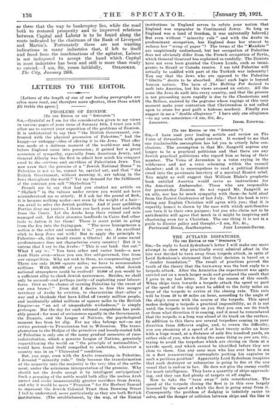THE JIITLA.ND DISPATCHES.
[To THZ EDITOR or THE " STECTATOR."] Sjz,—In reply to Lord Sydenham's letter I will make one more attempt to show why practically every admiral afloat in the late war decided to turn away from torpedo attack, in spite of Lord Sydenham's statement that their decision is based on a " slender foundation." The result of practices proved the truth of the theory that the turn-away was the best reply to a torpedo attack, After the Armistice the experiment was again carried out on a much larger scale and produced the result that I gave in my last letter. Now for the reason of this result. When ships turn towards a torpedo attack the speed or part of the speed of the ship must be added to the forty miles an hour of the torpedo to arrive at the closing rate. This rate will be from 50 to 60 miles an hour, according to the angle of the ship's course with the course of the torpedo. This speed makes dodging a torpedo a practical impossibility, as it is not until, the torpedo is nearly on you that you can see its track or from what direction it is coming, and it must be remembered that the torpedo is a long way ahead of its track on the surface. In addition to this there are several torpedoes coming in your direction from different angles, and, to crown the difficulty, you are steaming at a speed of at least twenty miles an hour with a huge vessel, at a distance of only five hundred yards, on either side of you, who is doing the same thing as you are, viz., trying to avoid the torpedoes which are closing on them at a terrific speed, and which cannot be identified before they are close to them. Can any sane man who has ever been to sea in a fleet manoeuvring contemplate putting his captains in such a perilous position? Apparently Lord Sydenham imagines that each destroyer or submarine is going to fire at the one vessel that is end-on to her. He does not give the enemy credit for much intelligence. They have a quantity of ships approach- ing, and they can find plenty of targets at all angles.
Now to take the " turn away " into consideration. The speed of the torpedo closing the fleet is in this case largely lessened by the speed at which the fleet is going away from it. Consequently the problem of dodging is infinitely easier to solve, and the danger of collision between ships and the line-is
reduced to nil with skilful captains. With regard to the question of deployment, Lord ,Sydenham does not realize that decreased visibility makes no difference to the danger of having your "T" - crossed; in fact, it rather increases it, for out of the mist come a succession of enemy ships firing at you with guns and tor- pedoes and disappearing again in a mist until the whole enemy broadside has been fired at you and, your successors at the point where you have been obliged, to turn by the fact of their cross- ing your "T." To take the case of Jutland, if Lord Jellicoe had deployed to starboard, his " T " would have been crossed, and his loading ships would probably have been sunk by the first two ships of the enemy, and the remaining vessels, as they came to the turning-point, would have received the same punishment from successive German vessels as they came into action. It seems a pity that a man of Lord Sydenham's weight with the public should criticize practically all the admirals afloat on their decision on a vital subject on which he has no practical knowledge. There is a proverb in the Navy that "a ton of theory is not so useful as an ounce of practice." In these matters we have had the " ton of theory " supplemented by many "tons of practice," while Lord Sydenham, one would judge, has to subtract all the practice from his knowledge of the subject and is only left with considerably less than a " ton



































 Previous page
Previous page